Analysis of Mechanical Properties of Four-Section Composite Columns of Pinus sylvestris var. Mongolia of Ancient Wooden Architecture under Axial Compression Load
Abstract
1. Introduction
2. Test Design
2.1. Materials
2.2. Specimen Preparation
2.3. Testing Procedures
3. Analysis of Test Results
3.1. Experimental Phenomena
3.2. Failure Modes
3.3. Load–Displacement Behavior
3.4. Stress–Strain Behavior
4. Quantitative Analysis
4.1. Ultimate Bearing Capacity
4.2. Stiffness and Stability Coefficient
4.3. Ductility
5. Conclusions
- (1)
- When the length of the wooden column remains constant, changes in the cross-sectional size of the concealed mortise and the length of the wedge do not alter the failure mode of the specimen. The specimen mainly undergoes three working stages during axial compression: the elastic stage, the elastic–plastic stage, and the plastic stage.
- (2)
- The tenon cross-sectional area has a significant effect on the load-carrying capacity, stiffness and ductility coefficients of the specimen and a relatively small effect on the stability coefficient. The ultimate load-carrying capacity decreases with increasing tenon cross-sectional area of the specimen and the ductility decreases with increasing tenon cross-sectional area. The ultimate load-carrying capacity of the specimens decreased by 7.3–11.9% for tenon cross-sectional area ratios of 44.5–100% compared to the specimens with the largest tenon cross-sectional areas. The axial stiffness of the specimen increases and then decreases with the increase in tenon cross-sectional area, which corresponds to the change rule of ductility. Stability coefficient with the increase in tenon cross-sectional area overall tendency to decrease.
- (3)
- In addition, the length of the tenon also has an effect on the load-carrying capacity, stiffness and ductility of the specimen. The size of the tenon length has a more obvious effect on the ultimate load capacity of the specimen within a certain range. When the tenon length is reduced from 60 mm to 30 mm, the ultimate load capacity of the specimen does not change significantly, and 60 mm can be taken as the design standard value of the ultimate load capacity of the four-section joint column. At the same time, the ductility of the specimen is best when the tenon length is 60 mm, increasing the length of the tenon can effectively improve the load-bearing capacity and deformation capacity of the laminated timber columns.
- (4)
- The current study was limited to sample data with a small sample size, which may affect the generalizability and statistical significance of the findings. Future studies try to increase the sample size and diversify the sources to verify the generalizability and reliability of the findings. Studies on ancient wood buildings should consider more carefully the effects of environmental conditions on material properties, such as humidity changes and long-term exposure conditions. It is hoped that the sample data in Table 4 will continue to be increased in the future, and the relevant mechanical property parameters of this component will continue to be supplemented, so as to provide the experimental basis for the establishment of the subsequent strength model and the constitutive relationship, which can provide a more scientific and reliable technical support for the protection and restoration of ancient buildings.
Author Contributions
Funding
Informed Consent Statement
Data Availability Statement
Conflicts of Interest
References
- King, W.S.; Richard, Y.J.Y.; Alex, Y.Y.N. Joint characteristics of traditional Chinese wooden frames. Eng. Struct. 1996, 18, 635–644. [Google Scholar] [CrossRef]
- Zhao, H.T.; Zhang, F.L.; Xue, J.Y.; Xie, Q.; Zhang, X.; Ma, H. Research review on structural performance of ancient timber structure. J. Build. Struct. 2012, 33, 1–10. [Google Scholar]
- Siha, A.; Zhou, C. Experimental study and numerical analysis of composite strengthened timber columns under lateral cyclic loading. J. Build. Eng. 2023, 67, 106077. [Google Scholar] [CrossRef]
- Pang, S.J.; Oh, J.K.; Hong, J.P.; Lee, S.J.; Lee, J.J. Stochastic model for predicting the bending strength of glued-laminated timber based on the knot area ratio and localized MOE in lamina. J. Wood Sci. 2018, 64, 126–137. [Google Scholar] [CrossRef]
- Li, H.; Qiu, H.X.; Lu, Y. An analytical model for the loading capacity of splice-retrofitted slender timber columns. Eng. Struct. 2020, 225, 111274. [Google Scholar] [CrossRef]
- Li, Z.; He, M.; Tao, D.; Li, M. Experimental buckling performance of scrimber composite columns under axial compression. Compos. Part B Eng. 2016, 86, 203–213. [Google Scholar] [CrossRef]
- Han, Y.; Chun, Q.; Xu, X.; Teng, Q.; Dong, Y.; Lin, Y. Wind effects on Chinese traditional timber buildings in complex terrain: The case of Baoguo Temple. J. Build. Eng. 2022, 59, 105088. [Google Scholar] [CrossRef]
- Chu, Y.P.; Shi Bixin Gong, Y.D. Experimental study on compressive behavior of intermediate slender timber columns with local damage and the retrofitting techniques for the damaged columns. Structures 2022, 46, 1709–1725. [Google Scholar] [CrossRef]
- Qin, G.Z.; Li, M.; Fang, S.Y.; Deng, T.; Huang, C.; Mao, F.; Zhao, Y.; Xu, N. Study of a grid-based regional localization method for damage sources during three-point bending tests of wood. Constr. Build. Mater. 2024, 419, 135348. [Google Scholar] [CrossRef]
- Thamboo, J.; Navaratnam, S.; Poologanathan, K.; Corradi, M. Experimental investigation of timber samples under triaxial compression conditions. J. Build. Eng. 2022, 104891. [Google Scholar] [CrossRef]
- Kia, L.; Valipour, H.R.; Ghanbari-Ghazijahani, T. Experimental and numerical investigation of concentric axial loading on bar-reinforced composite timber columns at a large scale. Structures 2024, 60, 105920. [Google Scholar] [CrossRef]
- Shi, F.; Wang, L.B.; Du, H.; Zhao, M.; Li, H.; Wang, F.; Wang, S. Axial Compression Behavior of FRP Confined Laminated Timber Columns under Cyclic Loadings. Buildings 2022, 12, 1841. [Google Scholar] [CrossRef]
- Zhang, L.; Liu, C.; Zhou, T. Experimental study on mechanical properties of column foot of ancient timber structures—Take the drum-shaped plinth as an example. Structures 2022, 40, 1002–1013. [Google Scholar] [CrossRef]
- Xu, F.Y.; Zhang, Z.; Meng, X.M.; Wu, X.; Gao, Y. Axial compressive performance of cruciform timber-encased steel composite columns: Experimental investigation and buckling analysis through 3D laser scanning. Thin-Walled Struct. 2024, 201, 111968. [Google Scholar] [CrossRef]
- Wang, Y.; Huang, Q.Z.; Dong, H.; Wang, Z.Q.; Shu, B.Q.; Gong, M. Mechanical behavior of cross-laminated timber-bamboo short columns with different layup configurations under axial compression. Constr. Build. Mater. 2024, 421, 135695. [Google Scholar] [CrossRef]
- Dubois, F.; Dopeux, J.; Pop, O.; Metrope, M. Long-term creep behavior of timber columns: Experimental and numerical protocols. Eng. Struct. 2023, 275, 115283. [Google Scholar] [CrossRef]
- Navaratnam, S.; Thamboo, J.; Poologanathan, K.; Roy, K.; Gatheeshgar, P. Finite element modelling of timber infilled steel tubular short columns under axial compression. Structures 2021, 30, 910–924. [Google Scholar] [CrossRef]
- Zheng, Y.B.; Zhou, C.D. Axial compressive properties of intermediately slender circular ancient timber columns reinforced with high-performance bamboo-based composites. Structures 2024, 65, 106720. [Google Scholar] [CrossRef]
- Malhotra AS, K.; Sukumar, A.P. Reliability-based design of mechanically connected built-up wood columns. Can. J. Civ. Eng. 1991, 18, 171–179. [Google Scholar] [CrossRef]
- Song, X.B.; Frank, L. Laterally braced wood beam-columns subjected to biaxial eccentric loading. Comput. Struct. 2009, 87, 1058–1066. [Google Scholar] [CrossRef]
- Theiler, M.; Frangi, A.; Steiger, R. Strain-based calculation model for centrically and eccentrically loaded timber columns. Eng. Struct. 2013, 56, 1103–1116. [Google Scholar] [CrossRef]
- Li, S.Y.; Xu, Q.F. Compressive behavior of damaged timber columns: Experimental tests, degradation model, and repair method. Eng. Struct. 2023, 293, 116579. [Google Scholar] [CrossRef]
- A, S.H.; Zhou, C.D.; Yang, L.G. Experimental investigation on axial compression behavior of timber columns strengthened with composite reinforcement method. China Civ. Eng. J. 2021, 54, 1–9. [Google Scholar]
- Wei, P.; Wang, B.J.; Li, H.; Wang, L.; Peng, S.; Zhang, L. A comparative study of compression behaviors of cross-laminated timber and glued-laminated timber columns. Constr. Build. Mater. 2019, 222, 86–95. [Google Scholar] [CrossRef]
- Xie, Q.F.; Zhang, B.Z.; Zhang, L.P.; Miao, Z. Study on mechanical performance test and degradation model of naturally cracked timber columns. J. Build. Struct. 2022, 43, 210–222. [Google Scholar]
- GB 50005-2017; Standard for Design of Timber Structures. Ministry of Housing and Urban-Rural Development: Beijing, China, 2017.
- GB/T 50329-2012; Standard for Test Methods of Timber Structures. Ministry of Housing and Urban-Rural Development: Beijing, China, 2012.
- Cheng, X.W.; Yu, H.R.; Shi, M.Y.; Sun, X.L.; Lu, W.D. Axial compression test of glulam columns based on traditional splicing method. J. Nanjing Tech Univ. 2022, 44, 654–663. [Google Scholar]
- Kia, L.; Valipour, H.R. Composite timber-steel encased columns subjected to concentric loading. Eng. Struct. 2021, 232, 111825. [Google Scholar] [CrossRef]
- André, J.; Massimo, F. General notes on ductility in timber structures. Eng. Struct. 2011, 33, 2987–2997. [Google Scholar]
- Xu, F.Y.; Xuan, S.Q.; Li, W.; Meng, X.; Gao, Y. Compressive performance of steel-timber composite L-shaped columns under concentric loading. J. Build. Eng. 2022, 48, 103967. [Google Scholar] [CrossRef]
- Karampour, H.; Bourges, M.; Gilbert, B.P.; Bismire, A.; Bailleres, H.; Guan, H. Compressive behaviour of novel timber-filled steel tubular (TFST) columns. Constr. Build. Mater. 2020, 238, 117734. [Google Scholar] [CrossRef]



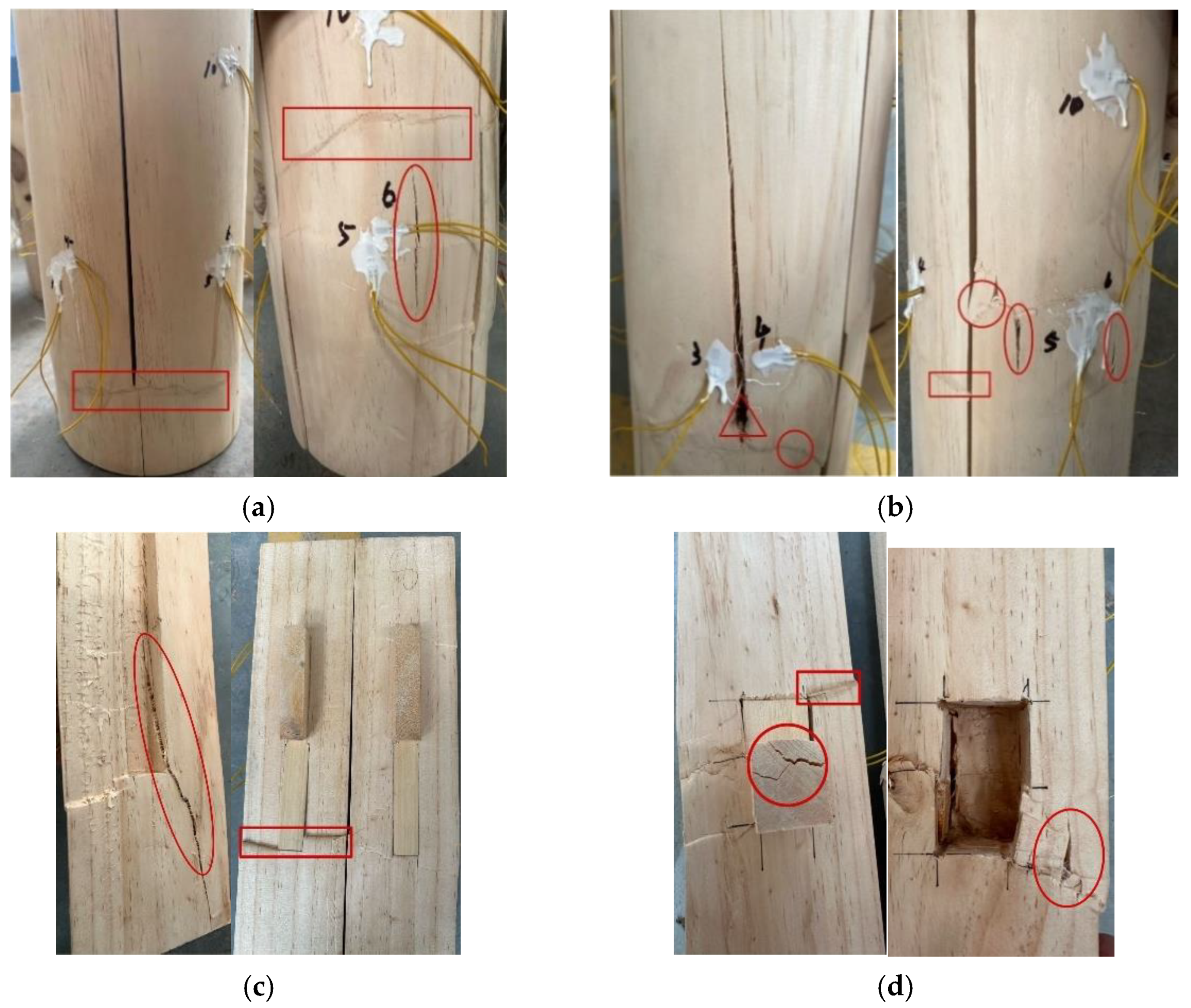
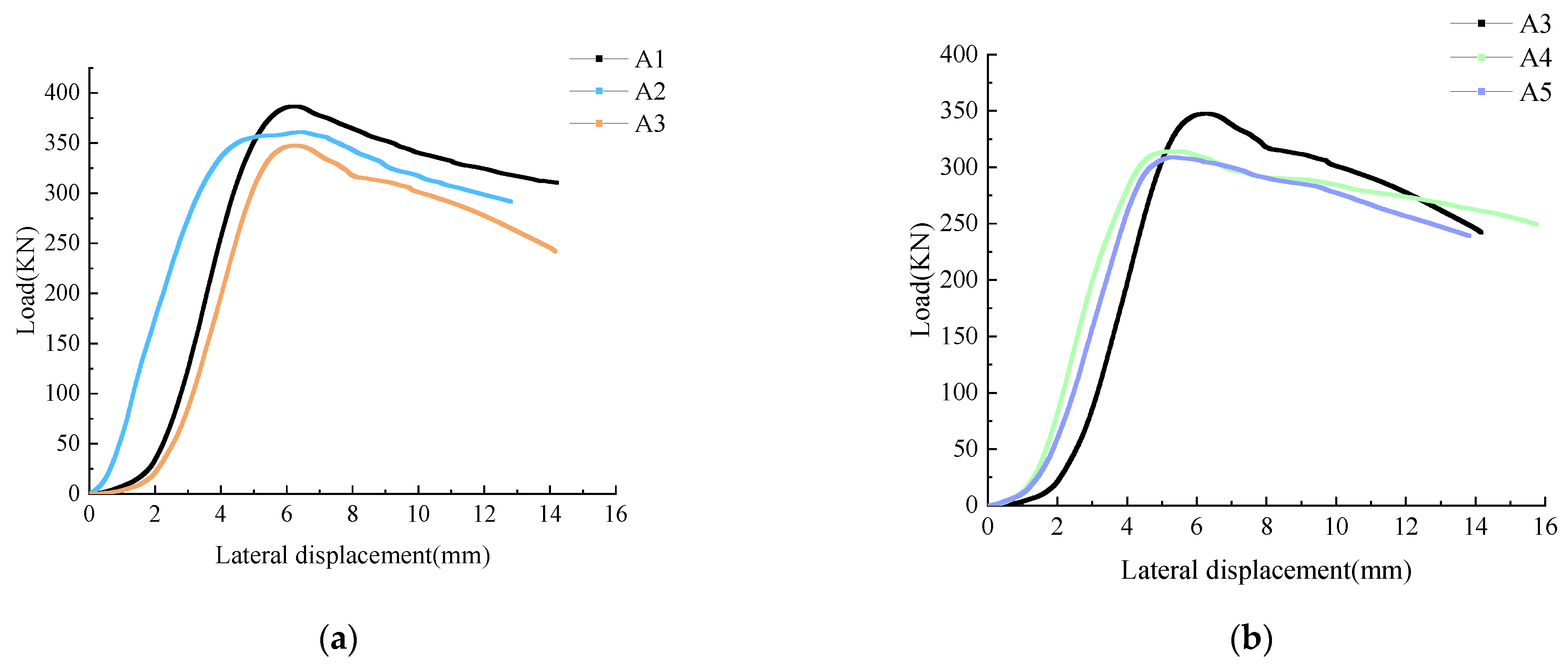

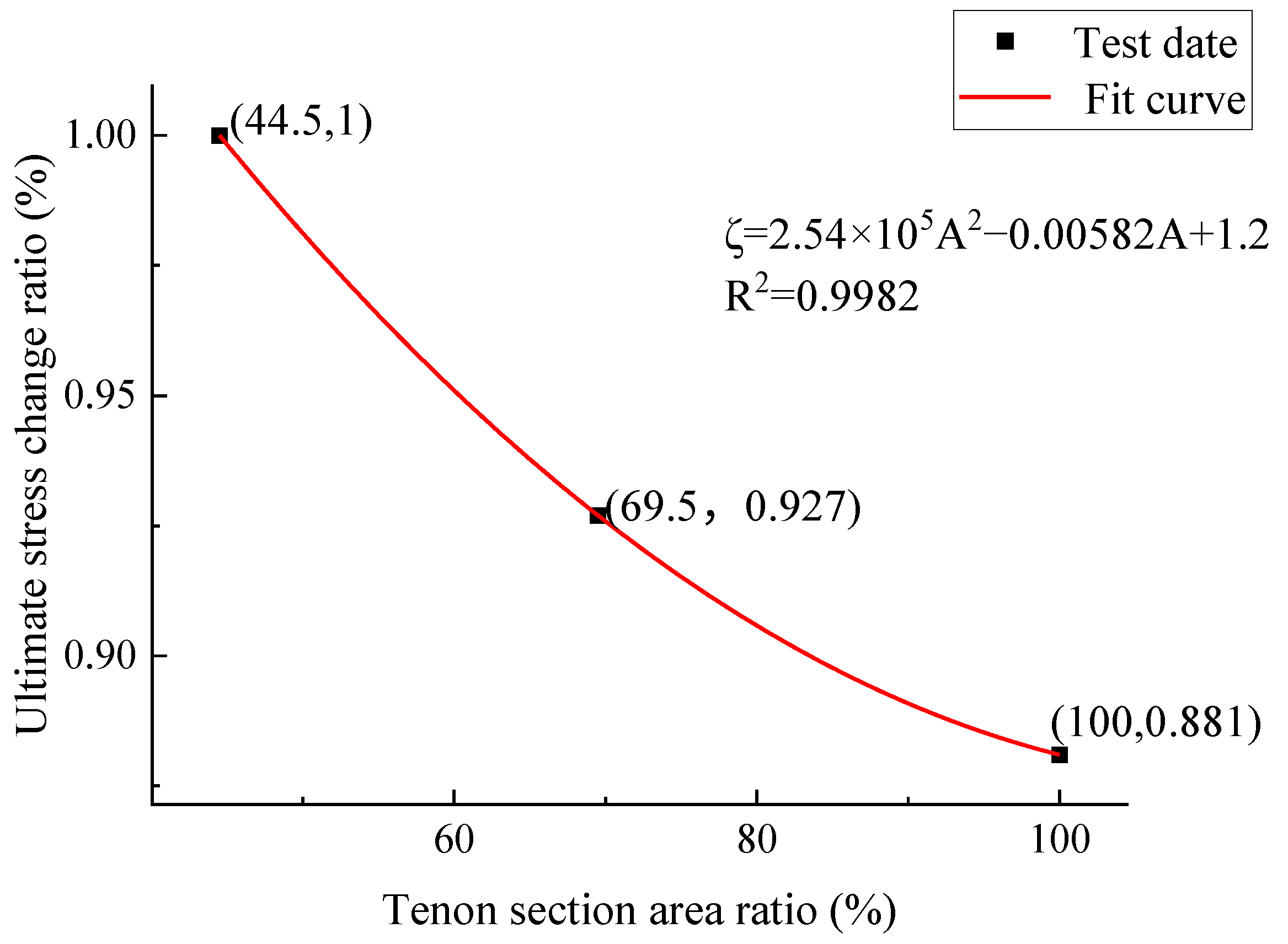
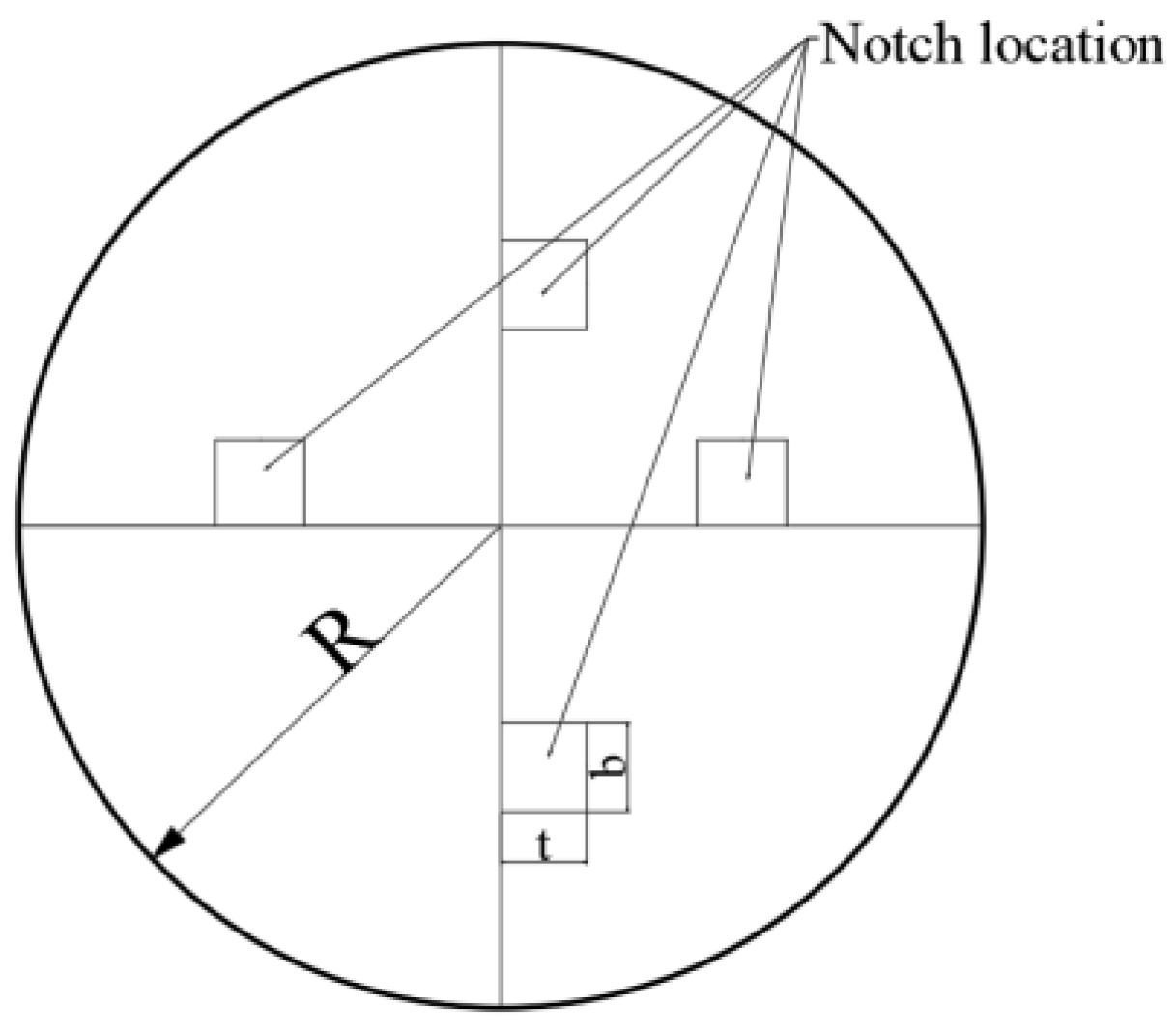
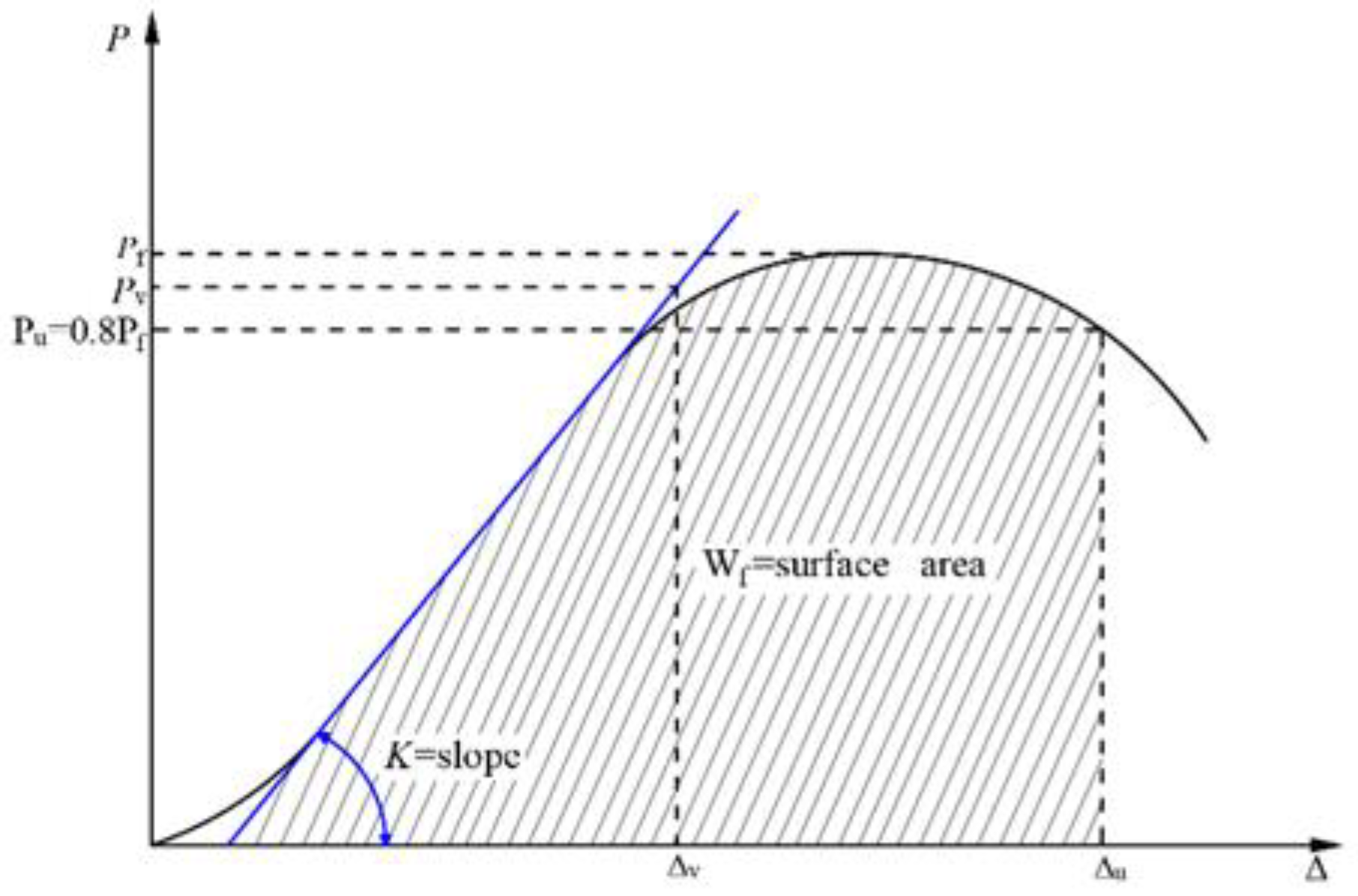

| EL/ MPa | ER/ MPa | ET/ MPa | ΜLR | ΜLT | ΜRT | GLR/ MPa | GLT/ MPa | GRT/ MPa |
|---|---|---|---|---|---|---|---|---|
| 10562.4 | 563.4 | 796.5 | 0.3 | 0.35 | 0.51 | 706.4 | 706.4 | 191.8 |
| Specimens No. | Length of Upper and Lower Surfaces/mm | Length of the Lower Base/mm | Thickness /mm | Length of Tenon Joint/mm | |
|---|---|---|---|---|---|
| A1 | a | 16 | 20 | 20 | 90 |
| b | 16 | 20 | 20 | 90 | |
| c | 16 | 20 | 20 | 90 | |
| A2 | a | 20 | 25 | 25 | 90 |
| b | 20 | 25 | 25 | 90 | |
| c | 20 | 25 | 25 | 90 | |
| A3 | a | 24 | 30 | 30 | 90 |
| b | 24 | 30 | 30 | 90 | |
| c | 24 | 30 | 30 | 90 | |
| A4 | a | 24 | 30 | 30 | 60 |
| b | 24 | 30 | 30 | 60 | |
| c | 24 | 30 | 30 | 60 | |
| A5 | a | 24 | 30 | 30 | 30 |
| b | 24 | 30 | 30 | 30 | |
| c | 24 | 30 | 30 | 30 | |
| Specimens No. | L/mm | Δu/mm | Pu/kN | Failure Mode |
|---|---|---|---|---|
| A1-a/b/c | 360 | 13.74 | 388.85 | Strength failure |
| A2-a/b/c | 360 | 12.82 | 372.9 | Strength failure |
| A3-a/b/c | 360 | 12.17 | 347.5 | Strength failure |
| A4-a/b/c | 360 | 15.05 | 316.1 | Strength failure |
| A5-a/b/c | 360 | 12.35 | 310.8 | Strength failure |
| Spcimen No. | Ultimate Compressive Stress σcu/Mpa | Ultimate Strain εcu/10−6 | Proportional Limit Stress σce/Mpa | Proportional Limit Strain εce/10−6 | Failure Stress σcf/Mpa | Failure Strain εcf/10−6 | Initial Axial Stiffness K/(KN/mm) | Variation Coefficient of Initial Axial Stiffness CoV/% |
|---|---|---|---|---|---|---|---|---|
| A1-a | 16.08 | 1825 | 11.26 | 1202.78 | 12.86 | 3815.56 | 107.63 | 8.84 |
| A1-b | 15.03 | 1586.94 | 10.52 | 1082.22 | 12.1 | 3815.56 | 121.98 | |
| A1-c | 15.02 | 1587 | 11.02 | 1084.54 | 12.55 | 3815.55 | 112.87 | |
| A2-a | 15.43 | 1836.39 | 10.8 | 981.39 | 12.34 | 3560.56 | 101.9 | 23.87 |
| A2-b | 14.41 | 1101.94 | 10.01 | 560.83 | 11.52 | 3255 | 139.88 | |
| A2-c | 14.55 | 1454.22 | 10.4 | 812.01 | 11.66 | 3335.2 | 129.56 | |
| A3-a | 12.80 | 1738.33 | 8.96 | 1087.78 | 10.24 | 2921.39 | 97.53 | 16.86 |
| A3-b | 15.02 | 1732.50 | 10.52 | 1289.72 | 12.32 | 3815.56 | 123.93 | |
| A3-c | 13.88 | 1735.42 | 9.58 | 1188.68 | 11.56 | 3541.26 | 112.86 | |
| A4-a | 13.19 | 1556.11 | 9.23 | 841.11 | 10.55 | 4180.28 | 130.57 | 24.31 |
| A4-b | 12.1 | 1396.11 | 8.47 | 981.39 | 9.68 | 4376.39 | 92.23 | |
| A4-c | 12.5 | 1486.52 | 8.88 | 912.08 | 9.85 | 4256.21 | 118.54 | |
| A5-a | 11.44 | 1272.78 | 8.08 | 869.17 | 9.15 | 3840.83 | 92.26 | 4.28 |
| A5-b | 13.45 | 1480.28 | 9.42 | 1076.67 | 10.76 | 3431.67 | 98.02 | |
| A5-c | 13.02 | 1345.20 | 9.12 | 956.42 | 10.22 | 3654.75 | 95.55 |
| Spciemens No. | Ip/106 mm4 | Ap/mm2 | ip/mm | λp | φ |
|---|---|---|---|---|---|
| A1 | 50.4166 | 23846.9 | 45.98 | 7.829 | 0.985 |
| A2 | 49.8841 | 22946.9 | 46.625 | 7.721 | 0.986 |
| A3 | 49.2349 | 21846.9 | 47.472 | 7.583 | 0.965 |
Disclaimer/Publisher’s Note: The statements, opinions and data contained in all publications are solely those of the individual author(s) and contributor(s) and not of MDPI and/or the editor(s). MDPI and/or the editor(s) disclaim responsibility for any injury to people or property resulting from any ideas, methods, instructions or products referred to in the content. |
© 2024 by the authors. Licensee MDPI, Basel, Switzerland. This article is an open access article distributed under the terms and conditions of the Creative Commons Attribution (CC BY) license (https://creativecommons.org/licenses/by/4.0/).
Share and Cite
Peng, S.; Qiao, Y.; Song, Y. Analysis of Mechanical Properties of Four-Section Composite Columns of Pinus sylvestris var. Mongolia of Ancient Wooden Architecture under Axial Compression Load. Buildings 2024, 14, 2438. https://doi.org/10.3390/buildings14082438
Peng S, Qiao Y, Song Y. Analysis of Mechanical Properties of Four-Section Composite Columns of Pinus sylvestris var. Mongolia of Ancient Wooden Architecture under Axial Compression Load. Buildings. 2024; 14(8):2438. https://doi.org/10.3390/buildings14082438
Chicago/Turabian StylePeng, Sheng, Yifan Qiao, and Yang Song. 2024. "Analysis of Mechanical Properties of Four-Section Composite Columns of Pinus sylvestris var. Mongolia of Ancient Wooden Architecture under Axial Compression Load" Buildings 14, no. 8: 2438. https://doi.org/10.3390/buildings14082438
APA StylePeng, S., Qiao, Y., & Song, Y. (2024). Analysis of Mechanical Properties of Four-Section Composite Columns of Pinus sylvestris var. Mongolia of Ancient Wooden Architecture under Axial Compression Load. Buildings, 14(8), 2438. https://doi.org/10.3390/buildings14082438






